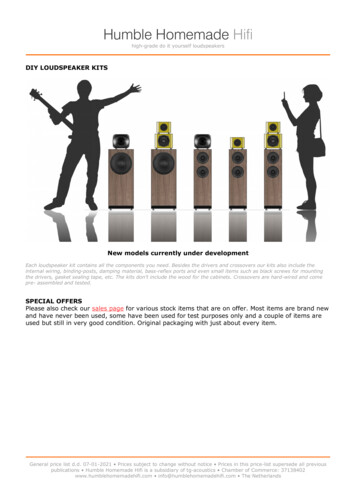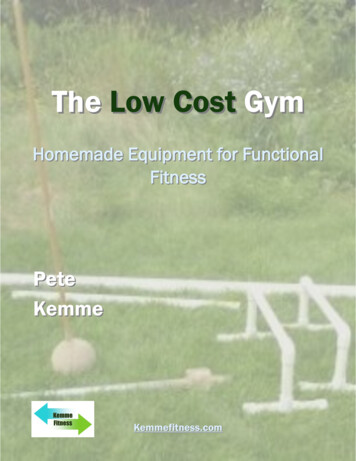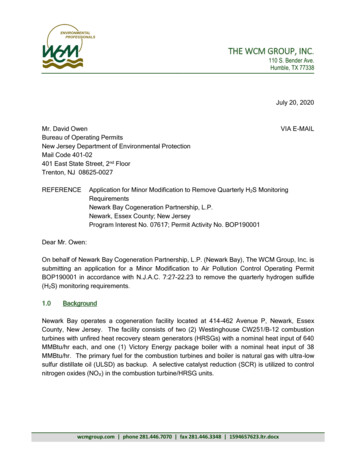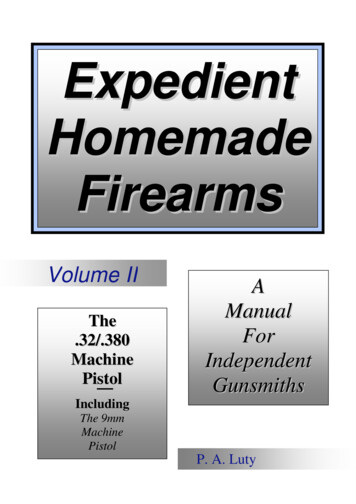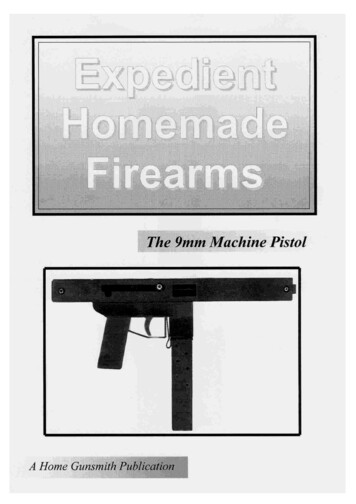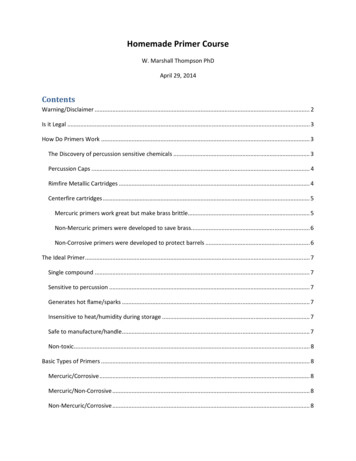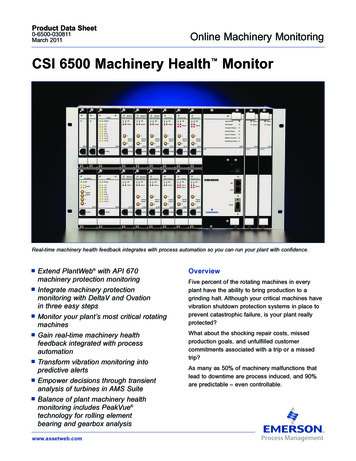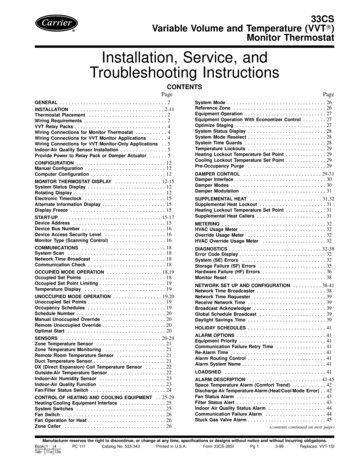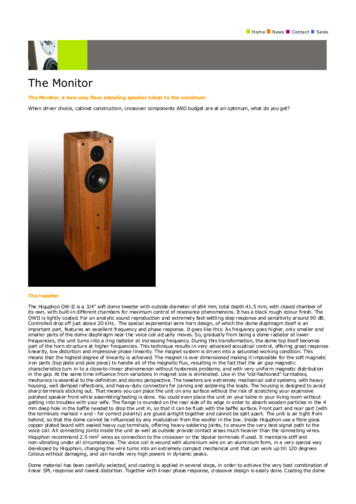
Transcription
H om eN ewsConta ctSa lesThe MonitorThe Monitor, a two-way floor standing speaker taken to the maximumWhen dri ver choice, cabinet construction, crossover components AND budget are at an optimum, what do you get?The tweeterThe Hi quphon OW-II is a 3/4" soft dome tweeter wi th outside diameter of ø94 mm, total depth 41,5 mm, with closed chamber ofits own, wi th built-i n different chambers for maximum control of resonance phenomenons. It has a black rough colour fi ni sh. TheOWII i s lightly coated. For an anal ytic sound reproduction and extremel y fast-settli ng step response and sensi tivi ty around 90 dB.Controlled drop off just above 20 kHz. The special exponential semi horn design, of which the dome diaphragm itsel f is animportant part, features an excellent frequency and phase response. It goes li ke thi s: As frequency goes hi gher, onl y smal ler andsmal ler parts of the dome diaphragm near t he voice coil act ually moves. So, gradual ly from being a dome radiator at l owerfrequencies, the unit turns i nto a ri ng radiator at increasing frequency. During thi s transformation, the dome top itself becomespart of the horn structure at higher frequencies. Thi s technique results i n very advanced acousti cal control, offeri ng great responseli nearity, low distortion and impressive phase l inearity. The magnet system is dri ven into a saturated working condition. Thi smeans that the highest degree of linearity is achieved. The magnet i s over dimensioned making i t i mpossi ble for the soft magneticiron parts (top plate and pole piece) to handle all of the magnetic flux, resul ting in the fact that the air gap magneti ccharacteristics turn in to a close-to-l inear phenomenon without hysteresis problems, and with very uniform magnetic di stribut ionin the gap. At the same ti me influence from variations in magnet size is el iminated. Like in the "old-fashioned" turntables,mechanics i s essenti al to the definiti on and stereo perspective. The tweeters are extremely mechani cal soli d systems, with heavyhousing, well damped reflecti ons, and heavy-duty connectors for joi ning and soldering the leads. The housing is desi gned to avoi dsharp terminals sticking out. That means you can place the unit on any surface without the risk of scratching your expensivepoli shed speaker front whi le assembl ing/testing i s done. You could even place the unit on your table in your living room wi thoutgetting i nto troubles wi th your wife. The flange i s rounded on the rear si de of its edge in order to absorb wooden particles in the 4mm deep hole in the baffle needed to drop the unit in, so that i t can be fl ush with the baffle surface. Front part and rear part (withthe terminals marked and - for correct pol ari ty) are glued ai rtight together and cannot be spli t apart. The unit is air ti ght frombehind, so that the dome cannot be i nfluenced by any modulati on from the woofer i n the box. Inside Hi quphon use a fibre glasscopper pl ated board with sealed heavy cup terminals, offering heavy soldering joi nts, t o ensure the very best signal path to thevoice coi l. All connecting joints inside the unit as wel l as outside provide contact areas much heavier than the connecting wi res.Hiquphon recommend 2.5 mm2 wires as connection to the crossover or the bipol ar termi nals if used. It maintai ns stiff andnon-vibrating under al l ci rcumstances. The voice coi l is wound with alumi nium wire on an alumi nium form, in a very special waydeveloped by Hi quphon, changing the wire turns into an extremely compact mechanical unit that can work up til l 120 degreesCelsius wi thout damaging, and can handle very high powers in dynamic peaks.Dome material has been carefully selected, and coating is appl ied in several steps, in order to achi eve the very best combination ofli near SPL response and l owest distortion. Together wi th li near phase response, crossover design is easil y done. Coating the dome
is made in several steps developed during many years, and i s in fact one of the secrets of the high qual ity and producti on equali tyfrom batch to batch. The inner damping is a world of its own! Damping of the cone suspension absorbs travel ling waves from thecone, and prevents from returning into t he cone making sum and difference tunes and break-ups (di storti on!). Venting of thechamber underneath the cone suspension is another important detail, and together wit h the chamber below the cone i tself (whichis vented to the special cotton wool damped rear chamber) Hiquphon offers a trebl e unit, which is top tuned and well damped atthe same time. Al l units leaving Hiquphon are tested at least tree times, two of which are listeni ng tests throughout the entirefrequency area. As a special test of t he mechani cal assembli ng, they test the unit through a completely crazy dividi ng network,givi ng the unit an awful bad time i n the area 100 Hz to 3000 Hz to make sure, that there is no rattl ing or other mechani cal noiseat all. (Thi s frequency area is the area i n which the resonances are most li kely to generate undesi rable mechanical noise if anymistakes have occurred and consequentl y will generate higher-order unequal-numbered harmonic distortion).The mid-wooferThe Audi o Technology C-Quenze 18 H 52 17 06 SD is based on the same technology as the Flexunits, but use a solid die castbasket i nstead of the modular basket used in Flexunits. The best part of energy during development was put into refinement of theperformance in the midrange area. Al l the materials used, were picked to obtain the trustworthiest mi drange reproduction. TheC-Quenze drivers are extremely fast and move without any dynamic compression due to the mechanical construction. The featuressuch as: SD system, Kapton voice coil former and under hung motor structure are still available in the C-Quenze dri vers. Hexacoilvoice coi l windi ng technique is used. The high ventil ation factor through the centre pole piece, under the rear suspensi on and theperforati on to the voice coi l, are natural ly kept intact, enabling the movi ng system to accelerate without any compression. Alsofrequency response curves i n the C-Quenze dri vers have been i mproved, compared to the Fl exuni ts.The passive radiatorThe Seas SP21R is a 21cm (8") polypropylene cone, low loss rubber surround, injection moulded zinc chassis passive radiatorintended for use, as an alternative to the vented port in a bass reflex cabinet, together with an active woofer of similar size orsmaller. In many applications the traditional bass reflex port may produce high-speed air noise or even have a poor effect due to asmall port area or a large port length. In such cases, a passive radiator may bring about an improvement. Mass has to be added tothe cone of the passive radiator in order to obtain the desired resonance frequency in a given cabinet volume. The passive radiatorcone is equipped with an M4mm screw to which you can easily fix the added mass. For optimum performance, the passive radiatorshould be mounted vertically (with horizontal cone axis) this is especially important when a significant additional mass is used. Likean active woofer, a passive radiator also needs time to “burn-in”. New from the box its resonance frequency is higher than when ithas been used for a while. I had to decrease the added mass after a few months of playing. I used 30mm diameter steel washers;in the end I needed 5 for each radiator. This tunes the cabinet to about 40Hz.Note the washers att ached to the rear of the SP21R.The cabinetThis monitor was to have as little compromises as possible so the cabinet must be also be built to very high standards. To keep thecabinet from “talking” its form and construction is very rigid and heavy. The cabinet walls are made of two different layers with atotal thickness of 40mm. The inside box is made of 22mm mdf covered on the outside with a layer of 18mm hard wood. Inside thereis an angled partition to separate the woofer volume from the crossover compartment. Due to the angled front baffle the onlyparallel walls are the sidewalls. All walls internally are covered with 4mm bitumen sheets to add even more mass and reducevibrations. Furthermore the crossover compartment is filled (through a removable base-plate) with dry sand after the crossover ismounted, also to add mass and reduce vibrations to an absolute minimum – the sand really helps to get even deeper and tighterbass. Damping material consists of wedge-moulded foam inside the top, bottom and sidewalls. The inside of the baffle and rear wallare kept free.
A higher resolution drawing available on request.Driver cutouts front and back.Crossovers and listening.Designing a crossover for the C-Quenze and Hiquphon drivers was very easy and at the same time very difficult. Because these twodrivers have such smooth frequency curves and low voice-coil inductance nearly every crossover will work with them – the difficultpart is which one sounds the best? So in the end I designed three different crossovers.Crossover nr.1 is an exercise at how to make the most simple crossover possible: the only filtering component is the small inductorparallel to the tweeter, this works as a high-pass for the tweeter and a minor low-pass for the woofer, it only smoothes the wooferslittle rise around 5kHz, so basically the woofer is running “full-range”. The last two octaves are then supplemented by the tweeter.The 10 ohm resistor parallel to the woofer acts as damping component for the tweeter output but its main reason is to stop a shortcircuit across the input terminals, without it the amplifier would only see the Rdc of the inductor as the load and switch intoprotection mode (if your amp has that feature!). This crossover sounds the most open and spacious of all the crossovers; younearly get the “full-range-driver-with-super-tweeter-effect” due to the minimalist filter component approach. It is also the mostdynamic and efficient version. Downside is t he speaker can sound a little thin when placed freestanding. To add body to the musicthis design must be placed close to a rear wall with just a few centimetres free to let the passive radiator breathe.Crossover nr. 1.Crossover nr. 2 is an attempt at still trying to let the C-Quenze do most of the work to maintain the open and spacious effect but atthe same time “tame” the speaker by adding a little baffle-step compensation by means of a second inductor and adding some moretweeter protection. This design must also be placed close to a rear wall to sound well balanced and add some body but is less criticaltowards bad recordings t han nr.1
Crossover nr. 2.Crossover nr. 3 finally takes a more standard approach. Fortunately the C-Quenze midwoofer has such a low voice-coil induct ance(only 0,13mH) that a Zobel network directly parallel to the woofer can be left out – the less components the better in my opinion.Compared to crossover nr. 2 a little more baffle step compensation is added by means of the 0,82mH inductor so the speaker willnow sound best freestanding. The 47 ohms parallel to this inductor is to keep a steady 6dB/octave acoustic roll-off even well abovefx. Also the crossover point is lowered from about 5500Hz to 3500Hz to give a more even off-axis response. All this results in avery even sounding speaker with a nice clear midrange. The treble has a silky smoothness to it and is also very revealing at thesame time. The speaker easily lets you hear the difference between a Stratocaster and a Telecaster. Bass is tight and reasonablydeep – the passive radiator produces a nice clean “thump” when you put your ear close to them. Imaging is larger than you wouldexpect from the physical size of the speakers, quite wide and placed in a large area around the speakers. The angled baffle andsimple crossover must contribute to this. To increase the tweeter level in crossover nr. 3 you should increase the value of resistorR3. Making it 33 ohms should give the tweeter about 2dB's extra level. You may need to experiment a bit for the exact value. Keepdoubling the value, so try: 15 / 33 / 68 / no resistor. Tune to taste!Crossover nr. 3.Crossover components:L1 0,47 mH Intertechnik Tritec inductor 3,5 mm wire, R 0,09 ohms or Mundorf CFC10, R 0,08 ohmsL2 0,82 mH Intertechnik Tritec inductor 3,5 mm wire, R 0,12 ohms or Mundorf CFC10, R 0,13 ohmsC1 10uF Intertechnik Audyn Cap Plus or Mundorf M-Cap Supreme polypropylene foil capacitorC1a 0,01uF Vishay MKP1837 polypropylene foil capacitorR1 2,75 ohms - 8x 22 ohms / 2 watts carbon film resistor parallelR2 47 ohms - 10x 470 ohms / 2 watts carbon film resistor parallelR3 6,8 ohms , 10 watts metal film resistor (tune the value to personal taste and system matching)Because all three crossovers are so simple don’t keep a tight budget when choosing the crossover components – the drivers areworth it!Measurements
Overall output level 200-20.000Hz; horizontal division 5dB and waterfall spectrum horizontal division 2dB.Passive radiator output level 20-20.000Hz; horizontal division 5dB and corresponding waterfall spect rum.Impedance curve 20-20.000Hz; horizontal division 2 ohms and corresponding phase horizontal division 15 degrees.These measurements were taken at 2 metres microphone distance with both speakers playing. The speakers were also 2 metresapart therefore forming an equal sided triangle between the microphone and the two speakers. I believe this to give a more realisticpresentation of the “character” of the speaker. Such an approach can never provide "absolute" data about a speaker's performance,because it also incorporates a few minor reflections – even with the gated MLS measuring technique I use you can’t remove theroom completely. However, it can be argued that this technique is actually more meaningful in terms of the actual listeningexperience. I've measured several speakers this way, and the results invariably show very good correlation between
The passive radiator The Seas SP21R is a 21cm (8") polypropylene cone, low loss rubber surround, injection moulded zinc chassis passive radiator intended for use, as an alternative to the vented port in a bass reflex cabinet, together with an active woofer of similar size or smaller. In many applications the traditional bass reflex port may produce high-speed air noise or even have a poor effect due to a
